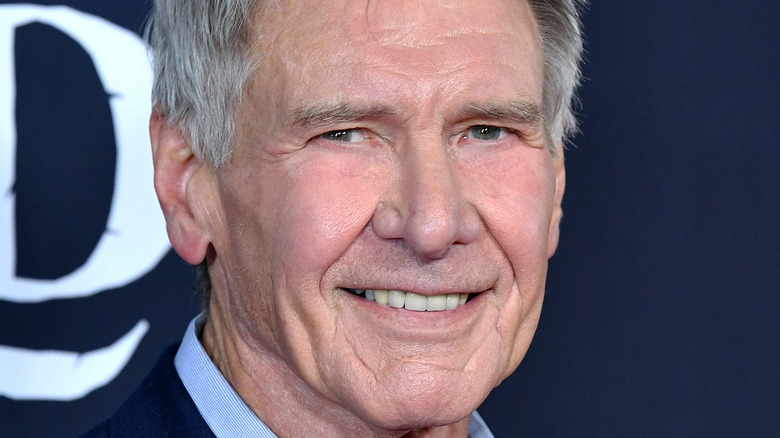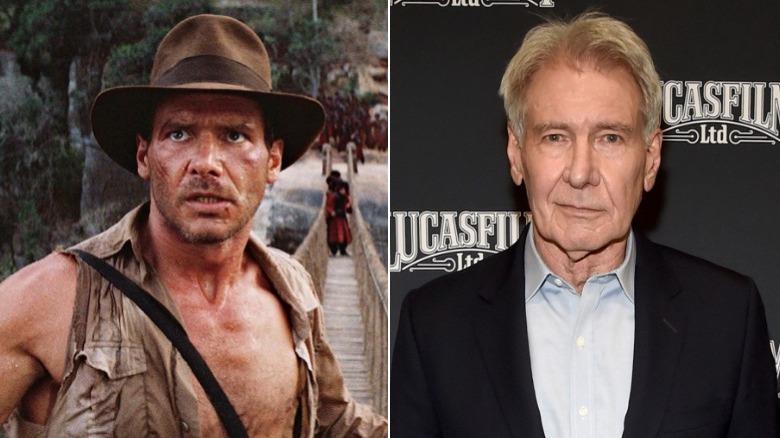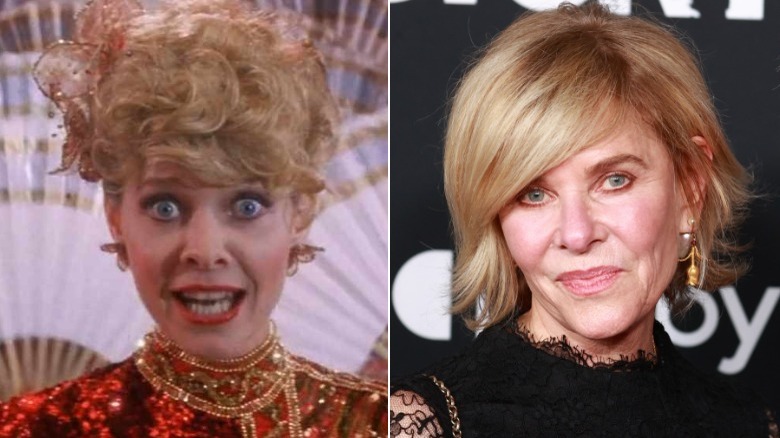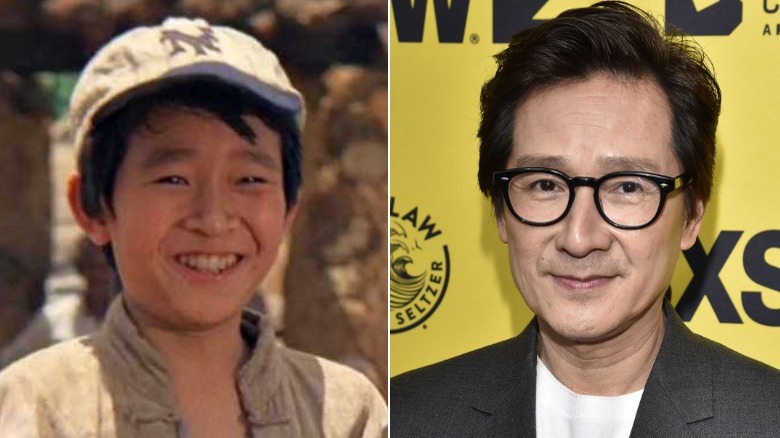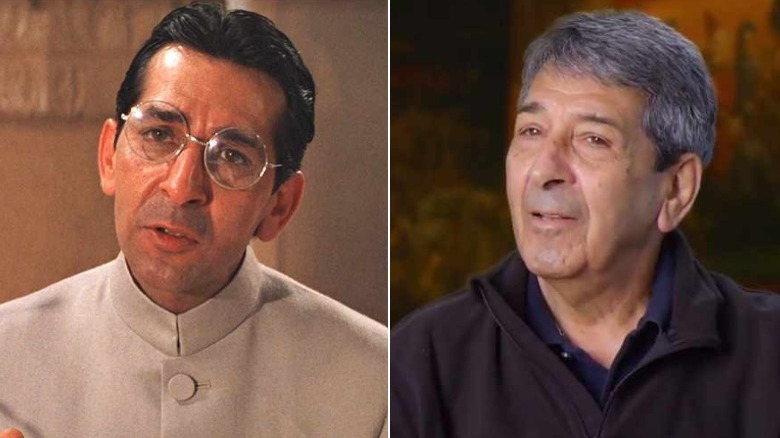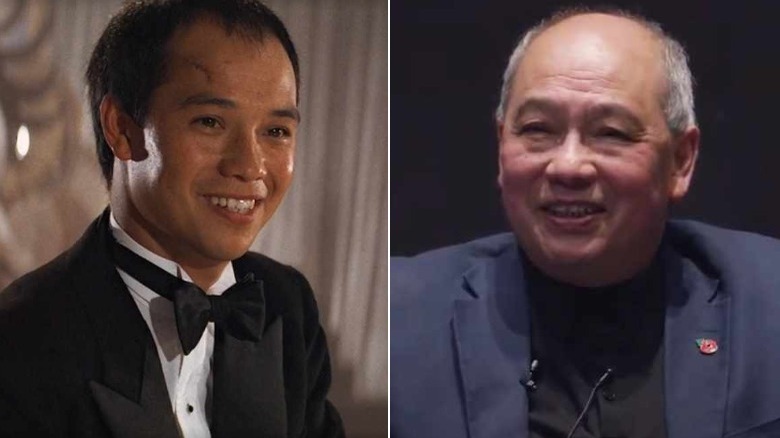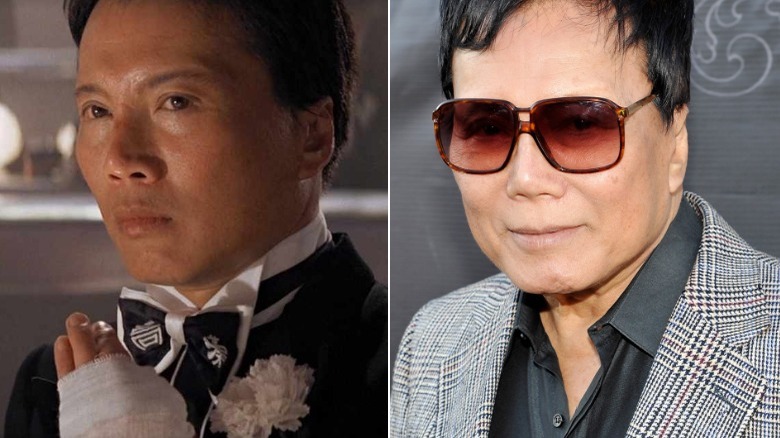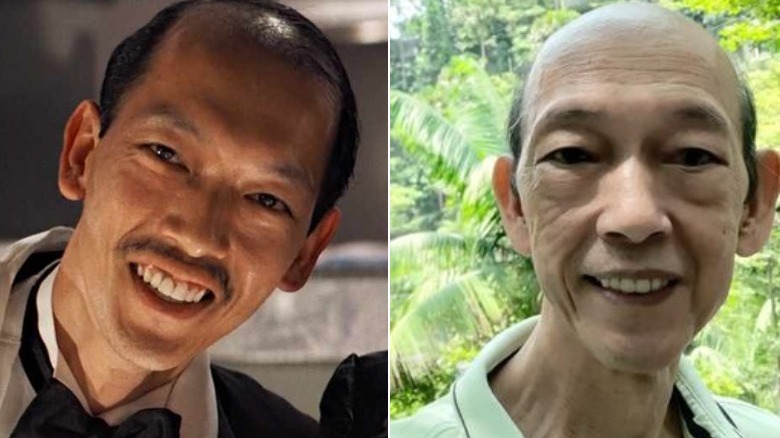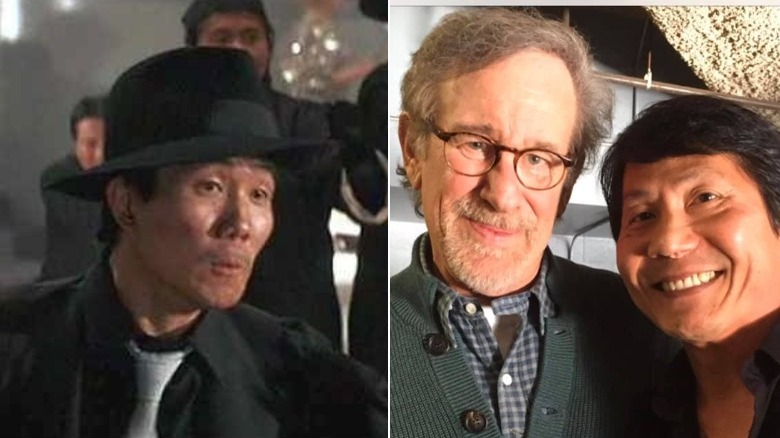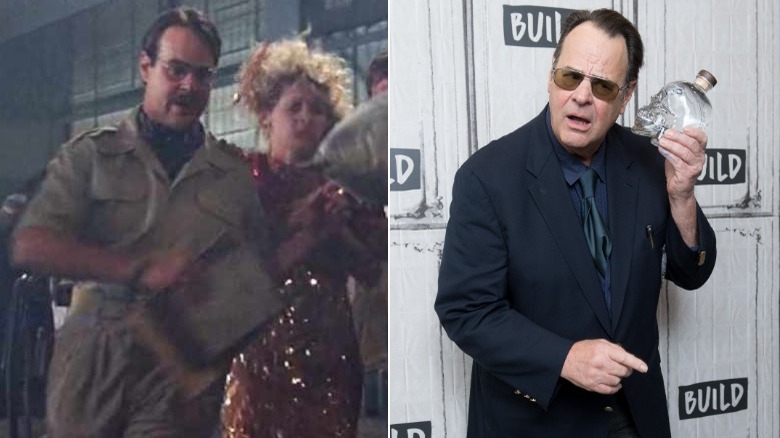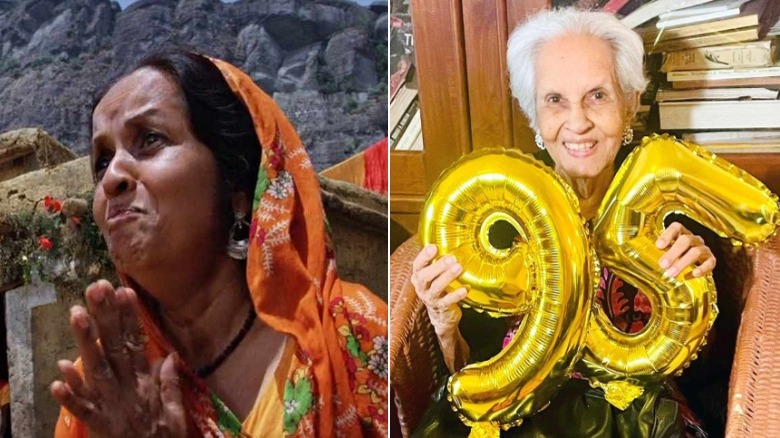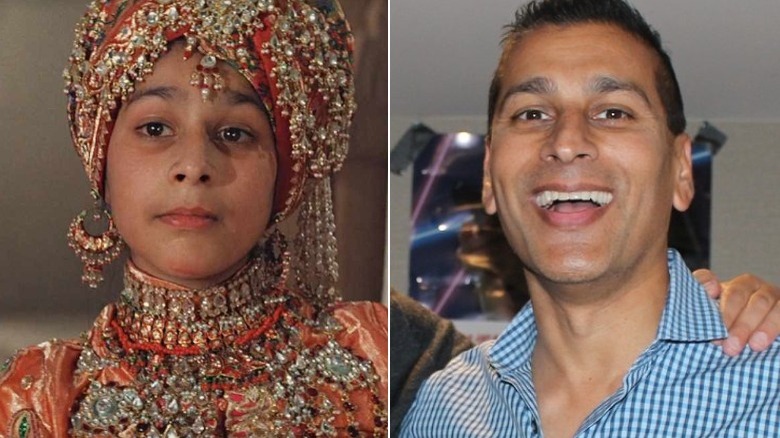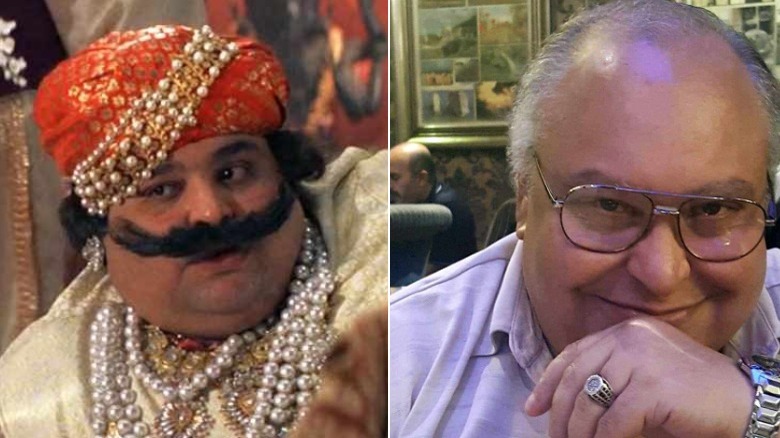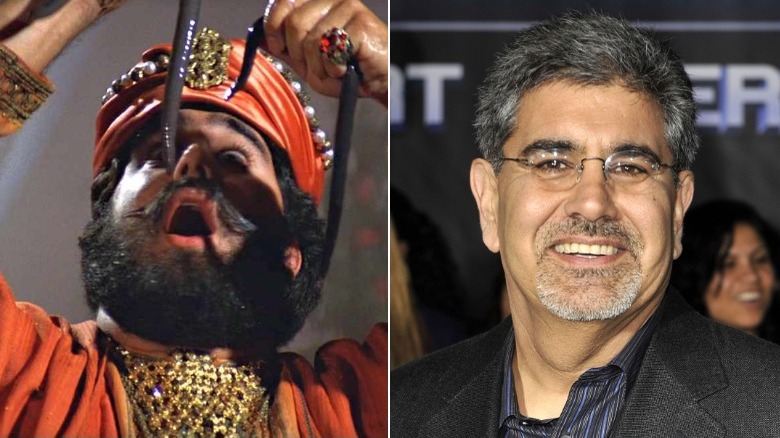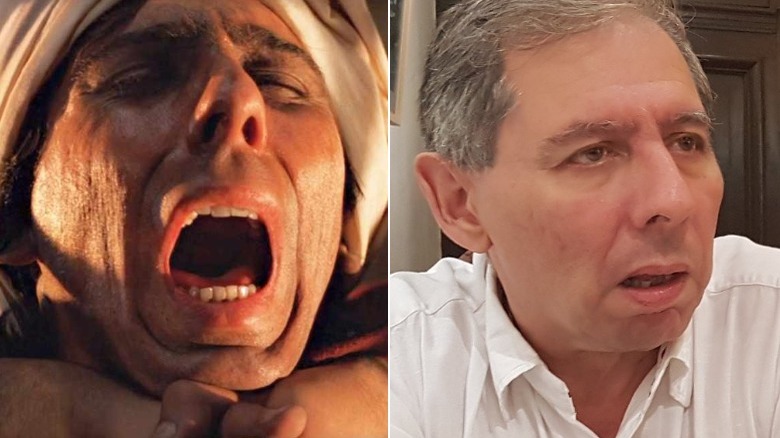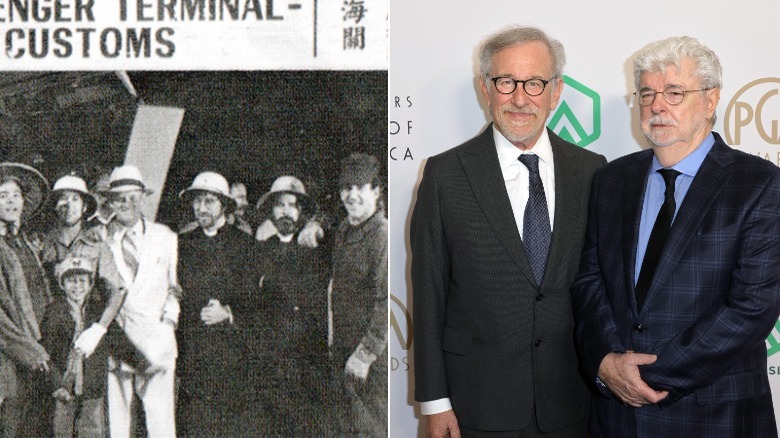What The Cast Of Indiana Jones And The Temple Of Doom Looks Like Today
Indiana Jones was born out of George Lucas' love of the movie serials of his youth, and after telling Steven Spielberg about him on a 1977 Hawaiian vacation, four years later Harrison Ford swung into theaters as the archeologist in their smash hit, "Raiders of the Lost Ark." Spielberg said as a part of their Hawaiian handshake deal that if they made the one Indy film, they would make two more.
In the vein of the "Star Wars" trilogy, like "The Empire Strikes Back," Lucas said "the middle part is the darkest part." Spielberg added that the "Raiders" sequel "was going to be more of a serious adventure for Indiana Jones, more of a dangerous ... a little scarier ... a little more like a nightmare" (via Making of) and revolved around a Thugee cult in the "The Temple of Death." It was renamed to the softer "Temple of Doom," but with its 215 acts of violence (per NCTV), its PG rating set off an outraged national debate, ultimately leading to the creation of PG-13 (although Spielberg favored it being called "PG-2," and then Paramount chief Barry Diller liked the sound of "R-13").
While the film is often seen as the dark middle child of the "Indiana Jones" franchise, it nonetheless broke box office records, won an Oscar for its groundbreakingly-gruesome visual effects, and for Spielberg, "the greatest thing that ever happened to me in my life came out of the 'Temple of Doom' experience and that is that the girl I cast to play Willie Scott turned out to be my wife."
Let's play archeologist and see what the girl who played Willie Scott looks like today — as well as her living co-stars, many who had their career made by the movie, and for some, remains their biggest claim to fame.
Harrison Ford (Indiana Jones)
Harrison Ford was once such an in demand carpenter that he took a three year break from acting. That all changed after he re-teamed with his "American Graffiti" director to play cinema's greatest rogue in "Star Wars," telling The Evening Post in 1978 that "even in my wildest dreams I never thought I'd end up rescuing a princess from a horde of silver-plated robots for a paycheck of a couple of million dollars. But still, it sure beats being a carpenter!" It seemed like his star couldn't shine any brighter, but it did when he donned a fedora and cracked a whip for Lucas and Spielberg as Indiana Jones in "Raiders of the Lost Ark."
When a "Raiders" sequel with a jungle setting was introduced to Ford, Spielberg recalled that the actor told Lucas "I think we should have elephants in this picture." 'Ultimately, I think it was the elephants that did me in,” Ford told the New York Times, explaining how riding them injured his back and sidelined him from filming, while everyone tried to carry on without him. While some consider it the lesser of the original trilogy, Ford does not, but did find it "unnecessarily graphic."
As a gigantic film star, Ford has always had to wrestle under the shadow of both Han Solo and Indiana Jones, telling the Times, "the relationship that audiences feel to me is not based on what I am, but on what fate has handed me in these roles.” After decades of sidestepping opportunities, he returned to a galaxy far far away one last time for 2015's "Star Wars: Episode VII — The Force Awakens" and saddled up as Indy for 2008's "Indiana Jones and the Kingdom of the Crystal Skull" and a fifth and perhaps final film in 2023.
Kate Capshaw (Willie Scott)
Kate Capshaw tired of life as a teacher and decided to make a go at acting, landing her first big role on the soap opera "The Edge of Night." A few years later, she made Spielberg laugh during her "Temple of Doom" audition, and landed the role of Willie Scott, who Capshaw told the Los Angeles Times was "strong and spunky and with a good sense of humor." She always had a fantasy of singing, and got to do so in the "Doom" opening scene, but said in the "Making of" that " it wasn't exactly a dream come true, because I had to sing in Chinese."
While Capshaw went on to become a leading lady in films like "Dreamscape" (the second movie ever film released as PG-13), "Spacecamp," "Black Rain," and "Just Cause," she also became the true leading lady in Spielberg's life. The two briefly dated in 1983, then rekindled their romance in 1988, while Spielberg was married to Amy Irving. Those two divorced in 1989, and Capshaw and Spielberg married two years later (with Harrison Ford naturally in attendance) and have 7 children between them. Capshaw hasn't acted since 2002, and one of her final credited roles was a movie she bought the rights to and Spielberg's Dreamworks produced: 1999's "The Love Letter." It went head-to-head at the box office as counter-programming to old pal George Lucas' "Star Wars Episode I: The Phantom Menace."
As for the "forgotten Indiana Jones movie" that brought them together, Capshaw told Empire, "If I walk into a room and it's on, we both have to sit down as we can both remember it like it was yesterday. We'll go, 'Oh yeah, remember that? You weren't talking to me during that part,' or, 'Oh, that was a really big flirt day. It was so much fun."
Ke Huy Quan (Short Round)
Steven Spielberg had a knack for finding child actors to bring "the truth" to his films, and struck gold again when he discovered Vietnamese refugee Ke Huy Quan to play Indiana Jones' sidekick, Short Round for "Temple of Doom."
Quan's brother initially auditioned for the role, but it was Ke Huy who stepped up and impressed the unknown to him "three grown men with a beard and a mustache" Spielberg, Lucas and Harrison Ford (via Vulture), and off he went to Sri Lanka (and even learned how to swim via Ford). Quan "steals the show," and Spielberg was so taken with him during filming said that he said "Ke is one the greatest experiences I ever had directing [not] only a child actor, but directing a complete unknown, a complete newcomer."
Quan followed up his instant stardom a year later in the Spielberg produced classic "The Goonies" as Data (where he met his lifetime friend and future entertainment lawyer Jeff Cohen) the TV series "Nothing is Easy," and later "Head of the Class." By the time he took a career in acting seriously, the roles began to dry up; as he told GQ, he "made the very difficult decision to step away from acting, it was painful, but I love this business so much," and then he enrolled at USC Film School. Quan would go on to work on stunts and action choreography for "X-Men" and "The One," and was an assistant director on Kar-Wai Wong's "2046," but after garnering some "serious FOMO" after seeing "Crazy Rich Asians," he decided to jump back into acting.
Quan recently earned good reviews alongside Michelle Yeoh and James Hong in 2022's "Everything Everywhere All at Once," and he tells GQ that his return "feels really good. I'm in such a good place. I'm so happy right now."
Roshan Seth (Chattar Lal)
A native of New Delhi who studied at The London Academy of Music and Dramatic Art, Roshan Seth told the Associated Press he was "torn between the two [India and England] — a leg in each of these cultures — never really knowing who I am." He's eschewed Bollywood, and is more at home in western cinema, enjoying "playing arrogant Indians" (via NPR). After six years off screens to work in journalism, he made a huge return to the industry in 1982, playing the first prime minister of India, Jawaharlal Nehru in Richard Attenborough's Best Picture-winning "Gandhi." Seth was nominated for a BAFTA for his work, and his follow-up project found him "working with this wiz kid director," Spielberg.
As Chattar Lal, Prime Minister to the Maharaja in "Temple of Doom," Seth told Empire he was "an Oxford-educated Indian smoothie who was a crook." Seth had "terrible hots for Kate Capshaw," and received a lot of heat from his fellow countrymen for the depictions of Indians in the film, especially over the banquet scene, which he called "a joke that went wrong."
Seth followed "Doom" in back-to-back years with the acclaimed films "A Passage to India" and "My Beautiful Laundrette," and later lent his steady voice and acting skills to Mira Nair's "Mississippi Masala," "Street Fighter" ("so bad" he walked out of the screening), and "Such a Long Journey," for which he won a Genie award for Best Actor. He later appeared in Michael Winterbottom's "Trishna," Tim Burton's live-action "Dumbo," and even slipped on his Nehru jacket one more time to play the Prime Minister in the 2007 TV movie, "The Last Days of the Raj."
David Yip (Wu Han)
One of seven sons of a Chinese sailor who married his British mother, David Yip grew up in Liverpool during Beatlemania, and was inspired to try his hand at theater after seeing a Black actor on stage and thinking he may have a chance to break his own barrier. Yip paid his dues in theater and British TV, and earned an early signature role as "The Chinese Detective," even crossing paths with Philip Tan and Chua Kao Joo.
That role helped him land the part of Indiana Jones' "old friend" of "many adventures," Wu Han, who goes "into the great unknown mystery" after being gunned down by Chua's Chen. Yip told Indymag that he found his time on set "very enjoyable," but due to delays in filming because of Ford's back, and a hitch in the schedule, he "went to the wrap party first and then I did my first day of shooting."
Yip told the Liverpool Echo that he often gets "sensitive, quiet roles or playing rich Chinese who went to Eton and Oxford," but always welcomes a break from those characters. He played a "fishy" CIA operative in "A View to a Kill," shared a call sheet with Ric Young three more times, appeared in Kenneth Branagh's "Hamlet," "Entrapment," "24: Live Another Day," and even wrote and performed in a play about his father, "Gold Mountain." While he is still a working actor, the devout Buddhist is "now enjoying the most demanding and exciting role of my life, being a granddad."
Ric Young (Kao Kan)
Kuala Lampur-born Wing-Wah Yung made a name for himself as Eric Young (shortened to Ric Young around 1978) in England. A student at the Royal Academy of Dramatic Art, he anglicized his name, telling The Straits Times in 1960 that he didn't want to be typecast, playing "the perennial Chinese houseboy." His first bit part was in the 1958 Ingrid Bergman film "The Inn of the Sixth Happiness," and he'd later co-star opposite Christopher Lee in a series of "Fu Manchu" films, Gregory Peck in "The Chairman," James Bond in "You Only Live Twice," and almost drowned for his part in 1965's "Lord Jim." He also logged small roles on shows like "The Avengers," "The Saint," "Hawaii Five-O," and on a few projects with Chua Kah Joo before the two would play the evil sons of Lao Che in "Indiana Jones in the Temple of Doom."
In an illuminating interview with Movie Geeks United, Young said "Temple" was "one of the greatest thrills of my life." He added that he looked "very determined and very angry" in his audition before Spielberg and Lucas, which helped to land the highly animated role of "Kao Kan, who was this sorta of smartass, tough gangster's son. He was the one who kept shooting with a tommy gun at Indy."
"Temple" put Young on the path to Hollywood, and he went on to appear in "The Last Emperor," "Dragon: The Bruce Lee Story," as Mao Tse-Tung in Oliver Stone's "Nixon," "Booty Call," "Seven Years in Tibet," 2000's "Chain of Command" with fellow Club Obi Wan gangster Philip Tan, a handful of "Alias" episodes and "The Transporter." In 2007 he wrote, directed, produced and starred in the short film about a Chinese rabbi, "Oh Vey!"
Chua Kah Joo (Chen)
As the 9th of 12 children in his family, Singaporean Chua Kah Joo told The Strait Times in 1981 that "everyone was doing something different, so I just took up ballet." He pirouetted all over the world, and eventually settled in the United Kingdom where he expanded on his martial arts expertise of Hung Gar, Karate, and Tae Kwon Do with Wing Chun.
In 1978, he also embarked on a decade-long career of film and television, "either cast as a crook or a cook," starting with the series "Gangsters" and culminating with the 1989 series "The Return of Shelley." When asked in 2019 what his favorite Kung Fu movie was, he told Mothership "I think it's Indiana Jones [laughs]. Because I am in it also," as Lao Che's other twisted smiling son Chen," he added, "I shot Indiana Jones' best friend, then he killed me with the skewer."
Chua founded and taught at two Wing Chun Martial Arts Academies in the UK, before returning back to Singapore in 2000, where he founded and is the dean of Sifu Chua's Wing Chun Kuen Training Centre. Sifu Chua sees Wing Chun Kuen as "a beautiful, unusual art as it applies the power and efficiency of our natural body structure to fend off aggressive confrontational force. Its graceful combat comes from the discerning ability of the Art's core principle – 'Knowing when to take action and when not to." He also fulfilled a lifelong dream to establish a ballet school in Singapore with his Midview Dance Centre. Now in his 70s, Chua can still throw 21 punches in 3 seconds.
Phil Tan (Chief Henchman)
Philip Tan is a Singaporean Brit who went from Youth Olympic gymnast to Men's British Tae Kwon do Champion to being able buy his own house at 18 after his first break into film, 1980's "The Fiendish Plot of Dr. Fu Manchu" starring Peter Sellers.
Years later, on the set of "Greystoke: The Legend of Tarzan, Lord of the Apes," he met "a guy named Steven" who asked him to work on "Indiana Jones and the Temple of Doom" choreography, without realizing who Spielberg was. Tan recalled to Kung-Fu Kingdom, "You can't be the director, you're like 30 years-old!" Tan trained Ke Huy Quan to fight, and even got to play the Chief Henchman who gets smacked in the face by a cymbal tossed by Dr. Jones. He re-teamed with Spielberg for "Empire of the Sun" and "Minority Report," and with George Lucas on "Willow."
After working on "Batman" he made the leap to America "and the rest is history," including doing stunt and fight work with the likes of Sylvester Stallone, Kurt Russell, Wesley Snipes, Sammo Hung, Jet Li, Jackie Chan, Jean-Claude Van Damme, Brandon Lee, Dolph Lundgren and Jason Statham. Frustrated with the limitations of roles offered in Hollywood, as he told the South China Morning Post in 2005, always killing people as "a gang member or a gangster. It's pretty sad," Tan has branched out into producing and directing, working on second units for such films as "Orgasmo" and 2022's "Commando. Nonetheless, he still works on stunts (his latest being Brad Pitt's "Bullet Train") and acting (co-starring in Antonio Sabato Jr.'s "Trail Blazers").
Dan Aykroyd (Weber)
The lives of Spielberg and Dan Aykroyd have crossed many times since the former made a cameo on "Saturday Night Live" in 1976. Two years later, Spielberg drafted Aykroyd and John Belushi for the notorious misfire "1941," and Spielberg would make a cameo opposite his stars a year later as a county clerk in "The Blues Brothers." In the 1982 Spielberg-produced "Poltergeist," the dog was named E. Buzz, a nod to Aykroyd's "SNL" character, and that same year, Aykroyd would present an Oscar to the "Raiders of the Lost Ark" team. The two also took part in the 1983 anthology film "Twilight Zone: The Movie."
When Spielberg was working on "Temple of Doom," Aykroyd called him up and asked him if he had "a little part in the movie for me?" (via Empire). They did, and he went up to Hamilton Airfield to play Art Weber, the man that helps whisk Indiana Jones away from the clutches of Lao Che. It was quite a summer in 1984 for Aykroyd, with "Temple" bowing on May 8, and "Ghostbusters" a month later. Aykroyd later took part in a short film called "Citizen Steve," to honor Spielberg's 40th birthday.
When Aykroyd was developing the spirits company Crystal Head Vodka it was around the same time that Spielberg was working on the 4th Indiana Jones adventure, "Kingdom of the Crystal Skulls." Aykroyd didn't want Spielberg "to think that I was ripping him off," and met with him to get his blessing, telling Empire, "because he is the Pope in the motion picture industry." Aykroyd has dedicated a lot of time to this business venture and told The Evening Standard "I don't see any film work in my future, unless Mr Spielberg comes calling."
Iranganie Serasinghe (Village Woman)
Iranganie Serasinghe, the "Beloved mother of Sinhala cinema," was called that because she was so adept at playing mothers in Sri Lankan films. The English trained actress first portrayed one in 1956's "Rekava," and was a natural to play one of the main village mothers in "Temple of Doom," yearning to see their enslaved child again (thanks to Indiana Jones, they do in the end). Serasinghe later relayed to colleague Michael Roberts that Spielberg "was impressed with the role I played, and after completing the film he told me 'I believed you.'"
Prior to "Temple," she had previously acted with her fellow "villager" actors and fellow Sri Lankans D.R. Nanayakkara (five other times, including her debut in "Rekava"), Dharmadasa Kuruppu, Ruby de Mel, Denavaka Hamine, and later with Roshan Seth in the 1998 TV movie "Iqbal." Serasinghe prefers the stage to cinema, and at age 95, shows no sign of slowing down. Now she's more prone to playing grandmothers, although when asked about playing great-grandmothers, she replied with a laugh: "I don't know."
Outside of acting, Serasinghe is a dedicated environmental activist and helped found Ruk Rakaganno (The Tree Society of Sri Lanka). She told Roberts that "we need not focus only on trees. But also on air we breathe, water we drink and irrigation, and sunlight that nourish all vegetation and the animals live near and far. All these are interconnected." Not only is she a mother of cinema, but one of the earth too.
Raj Singh (Little Maharaja)
When "his supreme highness, guardian of Pankot tradition, the Maharaja of Pankot, Zalim Singh" is introduced by Chattar Lal at the grand banquet, the guests gathered around the long table expecting to see someone of large stature to appear before them, they are surprised to see a "Little Maharaja" instead, played by British Sikh child actor Raj Singh. If his high pitched voice seems out of place, it's because Singh's lines were replaced in post-production by voice actress Katie Leigh. Outside of "The Temple," Singh has notched only a few other roles: 1981's "Kranti," a 1984 episode of "No 73" 1990's "Agneepath," and was a visitor to the set of the 1983 James Bond film "Octopussy."
Instead of pursuing acting as a career, Singh aimed for higher heights in the aviation industry. A proud graduate of the Sheffield School of Aeronautics, he worked for Comair Airlines, then DHL Airways, and is now a flight dispatcher for United Airline in Chicago.
While he has kept a low profile for many years, he returned to the limelight, embracing his "Doom" past when making his first ever convention appearance at the Knoxville Comic Con in 2017. As per Fantasy Expo, he became interested in appearing when he saw Ke Huy Quan in their guest line-up and "thought a reunion with his old friend would be fun." He has since made the rounds at other conventions, posing for photos and signing autographs.
Ahmed El Shenawi (Merchant #2)
Filling out small roles in a large way is something Ahmed El Shenawi has excelled at, ever since he moved from Egypt to England in 1971. He sounded off on the BBC Arabic Service radio, and in 1978 alone, danced in a Turkish prison in the Alan Parker/Oliver Stone Academy Award winning film "Midnight Express," then shared a bill alongside such heavyweights as Ian Holm, Roddy McDowall, Terrence Stamp and Peter Ustinov in "The Thief of Baghdad." According to El Shenawi's daughter Eman, Ustinov told her father that he was "'an actor with no problem,' implying that my father's talent is unquestionable and beyond doubt."
In 1984, his "barrel of laughs" career hit a zenith when he slapped on a mustache and turban and played a merchant who dined with Indiana Jones and other guests in "The Temple of Doom." Seated next to Capshaw's Willie Scott, who wasn't all too keen on his smell, he was so excited when the "snake surprise" dish was served (the snakes were actually jelly sweets). Spielberg was impressed with El Shenawi's work, and per his daughter, said, "Ahmed, you are a Shakespearian-type actor."
Later, after a stomach stapling operation, he lost half of his weight, and his acting career hit a crossroads, as his "character as the 'chubby Arab man'" could no longer be filled out. On the plus side, he was "thrilled that I could wear a better selection of suits!"
As per his daughter, El Shenawi still resides in London, is doing well and fondly remembers his acting days, especially "Indiana Jones," which remains "a big moment for him."
Arthur F. Repola (Eel Eater)
Acting roles (and eel eating) is not something you'll find a lot of credits for on Art Repola's lengthy Hollywood resume (his lone other role was as a member of the wedding band in 2002's "The County Bears"), as his talents are employed behind the scenes. In addition to being an overly hungry dinner guest at Pankot Palace in "Temple," he also worked as a production coordinator on the film, and according to The Raider.net, helped find a suitable background filming location for Mola Ram's cliff hanging death. Repola returned to "Indiana" as an associate producer on "The Last Crusade."
Repola has worked as a visual effects editor/supervisor and post-production supervisor on such classic '80s films as "The Empire Strikes Back," "Return of the Jedi," "Star Trek II: The Wrath of Khan," "Ghostbusters," "Goonies," "Back to the Future," "The Color Purple" and even the Universal Studios attraction "T2-3D: Battle Across Time." He told Cinefantastique in 1982 "I love this work because every movie is different, and everything stretches us and pushes the state of the art."
Repola has managed visual effects on nearly 200 films, for companies like Spielberg's Amblin Entertainment, Lucas' Industrial Light and Magic, and for Walt Disney Studios, where he was named a Senior Vice President in 1996. He also produced "The Indian in the Cupboard," "Ultimate X: The Movie," and 3D concert movies for Hannah Montana/Miley Cyrus and the Jonas Brothers.
Nizwar Karanj (Sacrifice Victim)
When actor Nizwar Karanj appeared on screens small and big in the early '80s, he often played to stereotypes, as he told Yahoo!, "they put a turban on my head and they browned me up." That included his biggest known role as the sacrifice victim in the "Temple," who not only has his heart ripped out of his body, but to add insult to injury, is burned to a crisp.
Nizwar never saw a script for this role, but did add to it, telling Spielberg he would chant "om namah shivaya" if he were in such a death-facing situation. While Nizwar didn't get burned (a body cast made of him did), his heart did skip a beat seeing Barbra Streisand and Carrie Fisher on set.
In the same year as the "Temple" release, he had a part in the Rod Steiger/Anthony Perkins mini-series "The Glory Boys," and would later appear in 1998's "Such a Long Journey," also co-starring Roshan Seth, in Atom Egoyan "Felicia's Journey" and in 2002's "Dirty Pretty Things." Nizwar admitted to Yahoo! that "theater was giving me much better parts, and I felt much nicer doing it," and he has earned praise for his work on the English stage, as being "engaging" and standing "out for his fine sense of comic timing."
But no matter what he's done, his sacrifice for cinema "follows me everywhere I go! I look back on 'Indiana Jones', and I really enjoyed it," adding "In my own small way, it's a sort of immortality."
Kathleeen Kennedy / George Lucas / Frank Marshall / Steven Spielberg (Cameo)
In the past four decades, four individuals have perhaps been more essential than any in creating the most beloved blockbuster films of the modern era: Spielberg, Lucas, Frank Marshall and Kathleen Kennedy.
Spielberg crossed paths with Lucas during film school, and the two eventually became best friends and box office rivals. While on vacation in Hawaii together, they hatched the idea to collaborate on "Raiders of the Lost Ark." Marshall caught Spielberg's eye as a busy assistant to Peter Bogdanovich, and brought him in years later to produce "Raiders." Kennedy was inspired after seeing Spielberg's "Close Encounters" to join the film industry, and after initially working as a secretary to John Milius, took on the same role for Spielberg and kept getting promoted. She worked with Marshall on "Raiders" to make miniature models, and the two fell in love.
Kennedy and Marshall would form Amblin Entertainment with Spielberg and produce his films, and would reunite with Lucas not only to put together "Temple of Doom," but to make cameos in the film as well. Spielberg, Lucas, Marshall, and Kennedy (and Sid Ganis) hung in the background as missionaries as Dan Aykroyd's Weber helped Indy and co. escape the clutches of Lao Che. Kennedy even doubled dipped cameos as an "Anything Goes" dancer at Club Obi Wan.
Cameos are nothing new for these titans of the industry; Spielberg has popped up in such films as "The Blues Brothers," "Gremlins," and "Vanilla Sky," while Lucas showed off his beard in "Hook," "Beverly Hills Cop III," and "Revenge of the Sith." Marshall appeared in three of Bogdanovich's films, as a pilot in "Raiders" and in "The Bourne Legacy." Kennedy hasn't logged another acting credit, but is a little busy these days running George's former company Lucasfilm.
